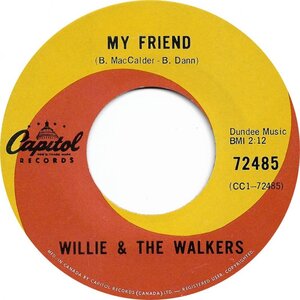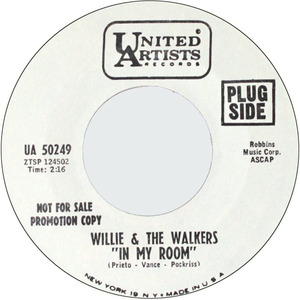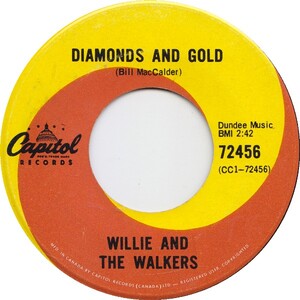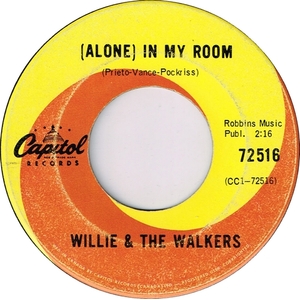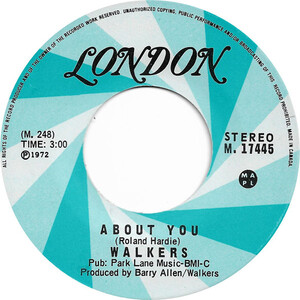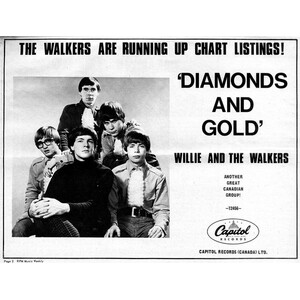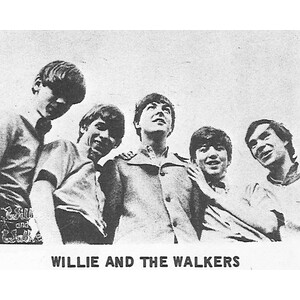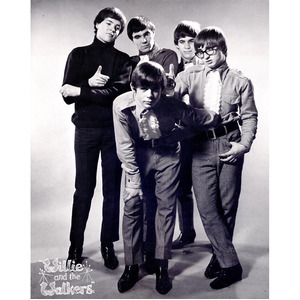Willie & The Walkers
Websites:
https://www.psychedelicbabymag.com/2018/11/the-rise-and-fall-of-willie-walkers.html
Origin:
Edmonton, Alberta
Biography:
Group portrait – L. to R: Will MacCalder, Bob Dann, Roland Hardie (front), Bill Hardie, Dennis Petruk, February 1967 photographer unknown, courtesy Rob Edwards
Vocalist/keyboardist Willie MacCalder formed the Walkers in 1963 with guitarists Bill Hardie and Dennis Petruk, and drummer Roland Hardie. The group signed with Capitol four years later and released two singles, "Diamonds and Gold" and "Alone in My Room." The Walkers disbanded in the early '70s (MacCalder began playing with the Powder Blues Band), but re-formed in 1988 for a reunion concert. Several changes later took place, including Roland Hardie being replaced by Nick Petruk and new additions vocalist Rick Francis, keyboard player R.J. Smarton and guitarist Sam Paladino joining the Walkers.
The seven years from 1965 to 1972 was a magic period in the history of Canadian popular music. Nowhere was that more true than in Edmonton. Alberta’s capital had a relatively small but remarkable musical scene – it could boast of two recording studios: CJCA and Downtown Recording Studio (later called Park Lane), three record labels: Pace, Damon and Molten, four booking agencies: Rayal Talent, Amroux Enterprises, Spane International, and Studio City Musical Ltd., three radio stations playing popular music: CJCA, CHED and CFRN, hip disc jockeys such as Bob Stagg, Chuck Chandler and Bob Gibbons, a popular music promoter like no other – Benny Benjamin, numerous hip nightclubs such as the Sugar Shack a-Go-Go, the Outer Limits, Zorba’s, the Forum, the Rainbow Ballroom, the Lakeview Pavilion, and finally a network of neighbourhood community halls which promoted local rock bands every weekend.
Edmonton was a nexus for original talent as well, with artists such as Mary Saxton and Barry Allen, and bands such as Wes Dakus & the Rebels, The Pharoahs (shortly to be renamed James & The Bondsmen), The Nomads, The Kingbeezz, the Lords (later to be rechristened Privilege), and L’il Davey & The Drastiks, Southbound Freeway, Graeme & The Waifer, The Young Ones, Cheyenne Winter, and Warp Factor. Most of these enjoyed regional fame, and several made it onto the national stage. Leading the pack for much of this period was the band Willie & the Walkers.
The original lineup included teenagers Will MacCalder, Bill Hardie, Rolie (Roland) Hardie, and Dennis Petruk. MacCalder, who would emerge as the band’s leader, was born in Victoria BC in 1947, but his family moved to Edmonton when he was an infant. His father was a contractor in the oilfields of Leduc. MacCalder was an early follower of the CFRN Hit Parade, and clearly recalls his liking for Bing Crosby, Jim Reeves, Prez Prado, Hank Williams, Patti Page, and later Fats Domino and Elvis Presley as he arrived at teenage-hood. He took piano lessons from a Mrs. Brooks in the Parkallen subdivision, but as it was classical music he was being taught, his attention wandered. He particularly enjoyed going through his grandparents and parents’ 78 rpm collections. His mother possessed what might have been his favourite record: Fats Waller’s “The Joint Is Jumpin’” with its lyrics “…get your hands off that broad, put away that pistol…”
There was a MacCalder household rule that strictly prohibited guitars, so Will, at the age of thirteen, took alto saxophone lessons at a local music store Harmony Kids. That led into his first band – a trio called The Barons – with drummer Ken Avison and guitarist Wes Shannon, playing songs like “Tequila” (The Champs) and “Wild Weekend” (The Rockin’ Rebels) at community halls. When they ran out of songs, Avison – a magician in training – continued the entertainment with his act. That was followed by The Casuals with Leonard Saidman, Marilyn Gardiner, Terry Merriman, Tony White and Ross Onyschuk.
In 1965 MacCalder graduated from Strathcona High and enrolled at the engineering school at the University of Alberta. After one term though, he found his enthusiasm waning, and he re-entered the world of music by joining The Tempests, again as a sax player. The band already featured the much acclaimed boy wonder drummer by the name of Rolie Hardie. The two hit it off immediately, and Hardie’s musical feel was used to bring MacCalder into the real world of music. Remembers MacCalder: “I thank him from the bottom of my heart. He taught me what it was to play in time! And he caught me on numerous occasions playing out of time! He just had the knack. He was a musician and I was just hacking time in comparison.”
The group wore powder blue Beatle jackets, and performed mostly instrumental hits of the day such as “Miserlou” (Dick Dale and the Deltones), “Telestar” (The Ventures) and “The Rise and Fall of Flingel Bunt” (The Shadows). The instrumentals were exciting but limiting, and thus MacCalder decided to make his vocal debut with Rosie & The Originals’ “Angel Baby.” He not only made it through without forgetting the lyrics (“it scared the shit out of me!…but I got nice applause…”), and was thus hooked on singing. As well he started playing the keyboards at this time – at the same time he got to know Barry Allen:
I met Barry Allen at a meeting of the Barry Allen Fan club, organized by president Sorelle Saidman. At one of these meetings the Tempests played. Barry would try to sing along with us – try to follow us. Barry was so cool – he could do Marty Robbins tunes, and here we were having trouble with “You Really Got Me.” That day the organ player didn’t show up…he didn’t even show up to pick up his organ…he had already left Edmonton, so I said “I’ll play it.” Everybody encouraged me, and we started really simple – “Louie, Louie.”
Another major component of the impending Walkers were the Hardie brothers – Bill and Rolie. They had been playing for some time before they became acquainted with MacCalder. Bill – born 1946 in Kelowna, BC – was the eldest son of Bill Sr. and Muriel Hardie. His formal training on guitar consisted of one year of lessons at the Olson School of Music, where for reasons he cannot quite remember, he concentrated on learning the Hawaiian steel guitar from Mrs. Clifford. As Hardie recalls with a chuckle “I’m sure visions of Don Ho went through my father’s mind! But it was not exactly what I was looking for – I knew there was something else out there…”
This false start was quickly remedied when he joined his first band, The Nobles, in the summer of 1963 which consisted of Hardie, Ron Slemko, Brian McKenzie, and on drums his younger brother Roland (Rolie) Hardie, born in 1949, also in Kelowna. They did primitive versions of instrumental hits such as “Walk Don’t Run” by the Ventures, and all members shared one amplifier.
They lasted a year, then Bill co-founded a slightly more sophisticated band called The Vacqueros with John Wesson, Mark Spacinsky, Pat Payne and the bespectacled guitarist Dennis Petruk. Although he started out playing guitar, Hardie soon switched to bass when it became obvious that no one else in the group wanted the job or was qualified to do it. They also dressed smartly – red velvet Spanish jackets with gold braid, black cummerbunds, and black trousers with a gold stripe down the side. They had synchronized dance steps and were not afraid to use them.
In the last few months of their existence, they recruited Rolie Hardie from the Tempests. As local musician Steve Boddington recalled in a blog:
It wasn’t until Jr. High school that I saw my first live band. “The Vaqueros” played Ottewell school. This was momentous because the drummer was Rolie Hardie who went to our school. They had matching blazers and had big time professional gear – Fender amps and guitars, and Rolie’s blue sparkle Slingerland drums. Denis Petruk played guitar and Bill Hardie was the bass player. Also, I believe the sax player was John Wesson….For a chubby kid with glasses…this was the road to perdition!
They then started looking over MacCalder. He remembers:
I was working as a stock clerk at Hughes Owens drafting supplies…and one day after work Bill Hardie and Dennis Petruk walked up the driveway…I knew them from the rival band – if you liked the Tempests, then you couldn’t like the Vaqueros and vice versa – We had met, seen each other around, and through Rolie they decided to ask me.
He gladly accepted, and Willie and the Walkers formed in August 1965, combining the core members of The Vaqueros with those of The Tempests. Their new name was an homage to their heroes at the time – Jr. Walker & the All Stars. MacCalder recalls the moment of the naming:
Dennis [Petruk] and I were driving on 76th Avenue, heading east through the Mill Creek Ravine. Jr. Walker and the All Stars were on the radio. Dennis said “We should call ourselves the Walkers”…I said “Yeh we could, but how about Willie & the Walkers?” And he said “that sounds pretty good.” They wanted me to be the focal point. I was ecstatic that I had this support from the band, and they were encouraging me to go ahead and sing and play the organ.”
The Edmonton Journal announced their formation in an article entitled “Organ Dominates New Sound Group”:
With a unique a-go-go beat and a new sound dominated by the organ, Willie and the Walkers made their debut as an Edmonton group only four months ago. Willie and the Walkers swing on stage in flashy short red jackets and black and gold pants. Newer outfits are planned. Spokesman, organist and lead singer is Bill MacCalder, Bill Hardie, bass guitarist; Dennis Tetruk [sic.], lead guitarist; and Rolie Hardie, drummer are the Walkers. The group is working on their own material and eventually would like to record. So far they play survey hits and newer songs. The Walkers have a different taste in music – soul music. They go for the Zombie [sic.], Beatle [sic.], and Paul Revere and the Raider [sic].
With their musical talents and complementary personalities, the Walkers gelled immediately, and quickly entered the ranks of Edmonton’s musical elite. For the first six months they were managed by local disk jockey Guy Good (the all-nighter “CHED Good Guy” – in real life known as Saffron Shandro) and their bookings – mostly high schools, churches, community halls and a club called The Pussy Cat A-Go-Go – were handled exclusively by Petruk’s aunt Sophie – known to all as “Toots.” Management duties were soon taken over by Wes Dakus. The founder of The Rebels was just bowing out of live performance, and saw his future (and money) in artist management, talent agencies, booking, and recording studio production.
In early 1966 the Walkers realized they needed to sign with a profession booking agency to get regular and better paying gigs. The only real choice was the Rayal Talent Agency. Rayal was founded by Ray Short and Al Johnson in August 1965. Working out of the Rayal Building at 10534 – 109th street, they promoted themselves as Edmonton’s first talent agency for popular music acts. By 1967 they had signed fifty bands, and their star acts included Mary Saxton, L’il Davey & the Drastiks, and The Lords (featuring Mel Degen).
From the beginning The Walkers realized they had to use the best and state-of-the-art instruments – something none of them could afford. However MacCaulder arrived at an understanding with a local musical store. Petruk recalled in 1992:
Harmony Kids was a music store in Edmonton owned by the Barabash family. Ronnie Barabash kind of liked us guys and he said “I’m going to take a flyer on you guys. You guys pay us $400 a month”, which was a lot of money, because bands were playing for $200 a night, “and you can have any equipment you want.” And we said “Wow!” Willie had the first Echosonic portable organ west of Toronto. .
Willie and the Walkers had youthful energy to burn, and their adrenalin-pumping performances got them onto the Saturday morning “CHED Bandstand.” The program was broadcast live from two other hip clubs the Sugar Shack A-Go-Go and The Forum. It was a finely tuned (and ever-changing) balance between bouncy pop numbers like Donavon’s “Sunshine Superman” and the Monkees “Last Train To Clarksville” to increasingly sophisticated tunes like Peggy Lee’s “Fever”, the Yardbirds’ “Shapes of Things”, the Left Banke’s “Walk Away Renee” and the Beatles “Day Tripper” to flat out versions of garage band nuggets like “Louie Louie”, “You Really Got Me”, “Kicks”, “Wooly Bully” and “Lies”. They literally moved into the Petruk’s basement full-time – they rehearsed every day for at least 5-6 hours, followed by a record – listening session looking for new material. Claims MacCalder:” we would change our set completely every three months.”
McCalder was still trying to master his instrument during this period. He learned organ solos from the records note for note (“I thought Alan Price’s solos were really good…as for Rod Argent [The Zombies] – I didn’t know where he was going…). There was very little improvisation onstage, and only one or two organ solos at all. Of course it may have sounded thin and cheesy for he was playing it all with his right hand. His left was occupied with working the equally cheesy light show.
MacCalder recalls gigs at the Sugar Shack A-Go-Go, managed by Dennis Hogarth and located at Stony Plain Road & 150th Street: “We got a great audience reaction. The kids just loved us – we had choreography, flashy suits, we played all the hits, AND we were the same age as them! To hear a live band in 1965 was not to be taken for granted.”
At least six (and one band member remembers up to ten) of their live broadcasts on the CHED Bandstand were recorded on the station’s log tapes. The band would make a point of going to the station to listen to them as a reference point for judging and shaping their live act. MacCalder recalls: “I remember listening to myself try to sing “And I Love Her”…they were so rough, and I was so out of key! And I was thinking – that was broadcast? Oh stinkage!”
Unfortunately no one thought to make dubs and thus the band’s live performances have not been saved for posterity. Word of these programs however started to attract the attention of record companies, but the band had no demo tape to give them. Accordingly in the late summer the band followed the lead of their mentors – Wes Dakus and Barry Allen – and drove down to New Mexico to record several songs for a demo tape. From the beginning the Walkers were intent on only recording their own songs and, except for a few notable exceptions, all of their released material was self-penned. MacCalder’s first hurried composition, based loosely on the “Walk Don’t Run” progression, was “Diamonds and Gold”. His second “Baby Do You Need Me” was patterned after The Animals “Don’t Let Me Be Misunderstood.” Petruk offered up “Can You See” and “Just Don’t Pretend.”
The site for their first recording session was the Norman Petty Studio in Clovis. Founded in 1954 by Petty (Buddy Holly’s producer and co-writer) it was a small and not particularly impressive edifice. Its dimensions were 10 ft. x 22 ft. and was described by Holly’s biographer as resembling “a 1930s gas station.” Still it had a most impressive track record. Roy Orbison had recorded “Ooby Dooby” and “Trying To Get To You” in 1956, Buddy Knox had put his 1957 million-seller “Party Doll” on tape there, Buddy Holly had recorded his two hits of 1957 there “That’ll Be The Day” and “I’m Lookin’ For Someone To Love”, and finally Jimmy Gilmour & The Fireballs recorded their “Sugar Shack” there in 1963. Add to this Petty’s publishing company and independent label Nor-Va-Jak, and it is not surprising that the establishment had a reputation second only to Sam Phillip’s Sun Studios.
The actual sessions, at which the four songs were recorded, took place over two sweltering days in July 1966. Even though they were extremely well rehearsed, MacCalder recalls that “we had to do seven or eight takes of each song before Norman heard something he liked.” He adds that Petty offered helpful hints: “He encouraged me to sing softer, more airy – put more breath into my voice. I’d never had any coaching, so I guess I was barking into the microphone!
It was an eye-opening experience for the tender young musicians. The studio was equipped with an Ampex 4 track recorder, then state of the art, as well as Telefunken and Neimann microphones. And, in particular the listening back to a properly recorded and separated piece of music on studio monitors with each track coming out of one of the four speakers was initially breathtaking. MacCalder:
I remember the first time I ever heard a playback of our music in a professional studio. It just did not relate to my ear. I thought “Who’s this? What is Norman playing us? I thought Norman was playing some sort of trick on us to show us what we should be sounding like. It was so clean and powerful! For a while I was really disoriented until I recognised that it was what we had just played! What a feeling!
Barry Allen helped with the harmony vocals. Again MacCalder:”…he learned the John Lennon/Phil Everly fifth below. Most people would take the thirds above – the most used harmony. Barry was such a monster harmony singer!!” Petty’s wife – Vi – came in after the band had returned home, and “sweetened up” some of the tracks with her organ. It did not help- instead it made it sound like MacCalder was playing a Teeny Genie organ which did not add to their credibility. Says MacCalder with commendable understatement:” We all thought it sucked.”
The timing was good – as they were starting to get mentioned on the national stage. Canada’s music industry magazine RPM dedicated most of its July 18th, 1966 Special Issue to music in Edmonton. The lead article “Edmonton: Canada’s Music City in the West” discussed the music infrastructure that was slowly coming together. There were numerous advertisements by local broadcasters, clubs, and the two talent agencies. It confirmed that there were “fifty regular working bands, several orchestras…small combos, country artists and jazz musicians are all deriving a fairly substantial living from their profession…” It ended with a warning:
Edmontonians have a liking for Edmontonians, which is a good start. Groups and artists are content to make a name for themselves in their hometown, and then gently spreading nationally. Watch for The Nomads, The King Beezz, James and the Bondsmen, Willie and the Walkers, Graeme and the Waifers, The Cat Family, the New Executives, The Exiled, the Kick a Poos, Today’s Specials, Sons of Adam, The Tyme Five, Fab 5, Famous Last Words, The Colours, and many more exciting Edmonton talent. Edmonton is truly THE MUSIC CENTRE OF THE WEST.
As early as September of 1966, Dakus had hyped the Walkers to another of his influential friends in the music industry – Paul White, then head of A&R at Capitol Records Canada. Based in Toronto, White had earned an immense reputation for spotting talent – three years earlier he had decided to release the single “Love Me Do” in Canada by a hot new Liverpool band, even though Capitol Records in the U.S.A. had passed on it. A couple of years later he would sign Anne Murray who would go on to become Capitol’s most popular and highest selling Canadian artist. White obviously liked the Walker demos, but did not want to make too quick a decision.
By November 1966, the Journal could report that:
Bill MacCalder of Willie and the Walkers has been given Jan. 1 as the tentative release date of the record the group recorded in Clovis, New Mexico. There is some talk about it being on the Capitol label.
Capitol finally took the plunge and signed them in early December. It was an auspicious period for the label. Under president Edward Leetham, and Paul White, they started to recruit and promote Canadian talent all helped by the profits pouring in from Beatle sales. By mid-decade, they had signed Les Atomes and Les Cailloux (Quebec), The Esquires and The Staccatos (Ottawa), Gary Buck (Sault St. Marie), Sugar Shoppe, Jack London & the Sparrow, Malka & Joso (Toronto), and from Edmonton Wes Dakus, Stu Mitchell, Barry Allen, James & the Bondsmen, and now Willie & the Walkers. They also started distributing several independent labels such as Hawk Records (Ronnie Hawkins, Robbie Lane), Roman Records (David Clayton Thomas & the Shays, The Paupers), and Yorktown (The Ugly Ducklings).
One could accuse Willie & the Walkers of being what we now know as a “boy band.” They had the boyish good looks that caused girls to scream – and it did not hurt that MacCalder, with his puppy dog eyes, bore more than a passing resemblance to Paul McCartney, and as a vocalist reminded listeners of Colin Blunstone of the British band The Zombies. They also had a somewhat fanatical Willie and the Walkers fan club which was started in November 1966 under president Barb Eastland. However the key difference was that they could write songs and could play their instruments – they were musicians first and foremost. And hoping to add to their fan base, The Walkers engaged in their first out-of-province “tour” the week after Christmas – hitting Lloydminster, Saskatoon and Regina in the music-conscious province of Saskatchewan.
At the beginning of January 1967, the Walkers decided to add a fifth member to augment their sound. Their choice was guitarist Bob Dann. Dann (b. 1947) was self-taught, and showed an early interest in jazz guitar. His formative influences included Wes Montgomery and Howard Roberts. However he too got caught up in the popular music boom of the early 1960s, and joined his first band in high school – The Pharoahs. Led by Dennis Ferbey, it included drummer Tommy Doran, and singers Judy Singh and Brenda Morrison. They became regulars on the CHED Bandstand radio program hosted by disc jockey Keith James. By 1965 their sound had evolved: they became enamoured of James Brown and other American rhythm & blues, and thus added a horn section consisting of Larry Hunter (saxophone), Jack Gordon (trumpet), and John Rutherford (trombone). As they were getting ready to record, they had the sinking feeling that they would not be signed by a major record company, and could even get into legal trouble if they kept the name Pharoahs. After all there was one extremely popular band – Sam the Sham and the Pharoahs – out there.
Keith James suggested they change to James & The Bondsmen, obviously to cash in on the 007 phenomena. The Bondsmen recorded a number of tunes in the Pepper-Tanner Studio in Memphis. As Dann Recalls: “Again it was Mr. Keith James. He knew these people, and actually the studio we used was a jingle studio…my interpretation [is] “We’ll buy the package off you if my boys can come down and record in your studio.”
They were signed to Capitol Records, and released three singles: “El Toredo” b/w “Get Smart”, “Look What You’re Doing to Me” b/w “Mister Soul”, and “Soup Time” b/w “Have You Ever Had the Blues.” For the last half of 1966, Dann jumped over to the Time Machine consisting of Bruce Nessel, Al Treen, Ken Brenzan and Steve Palmer. Palmer recalls : “The Time Machine played a lot of country dances doing the wrong kind of tunes. The people wanted the Monkees or Don Messer and we thought we were the Rolling Stones or the Fugs. It got tense sometimes….”
Dann bailed on this, and started teaching guitar at this point. He is still scratching his head:
How I thought I could teach guitar when I didn’t know how to read music I don’t know! I did that for a while, and then Will asked me and I said, “Sure, I’ll help out. If it doesn’t work I’ll go back to this, but I’m not here to take over the group, I wanna help you out.” That was my understanding—let me help you musically where I can and let’s get on with it. The ‘Journal’ thought Dann’s addition was newsworthy: Willie and the Walkers just back from a successful tour of Saskatchewan, have now added a new member to the band. Bob Dann, lead guitarist of the now defunct James and the Bondsmen, now plays six string lead guitar for the Walkers, while Dennis Petruk plays twelve string electric lead.
The Walkers moved into high gear during 1967. They were obviously listening to the right advisors and acquired their own practice studio near the corner of 101st Avenue & 72 Street (needless to say, it was also a serious party space), and formed their own company to handle their bookings. As reported in the Journal on January 27: “Willie & the Walkers, one of the best bands to come out of Edmonton, have formed a corporation to handle their bookings and engagements.”
They played a number of important concerts that winter and spring. In February they performed at the Muk-Luk Mardi Gras:
Willie & the Walkers will also be featured at the Muk-Luk Dance. New Walker Bob Dann had done wonders for the group’s sound. Their show is alive, slick and professional. The main characteristic of The Walkers is that they know exactly what they’re doing and love doing it. It shows when they perform.
On March 18th, they opened for a four-band show at the Sales Pavilion headlined by Paul Revere and the Raiders and put on by the American firm Northwest Releasing. Barry Westgate of the Journal – normally pretty hip to popular culture – reviewed it like an old man. He bemoaned the:
… monstrous bashing on a set of drums at the back of the stage, to override, shape and insist the wild cacophony of noise that is this electronic age of teen-age entertainment. But don’t knock it too quickly. There were close to 5,000 teeny-boppers there and they simply loved it. No wild, wild screams. No concerted, panicky rush for the stage, but they loved it, all the way from Paul Revere and the Raiders of the upper echelons of teen entertainment to Willie and the Walkers of the local scene. In between were Roy Head and The Viceroys….The music didn’t matter, what there was of it. Just the beat, the flopping heads, the abortive gyrations….
“Diamonds and Gold” was finally released at the beginning of May 1967. It entered the RPM Canadian chart at #14. It spent ten weeks on the chart, and managed to make it to #3 during the weeks of June 17th and 24th. That same May founding member Dennis Petruk left the band. Something was just not working. Of course it did not help that their first single had the two MacCalder-penned tunes they had recorded – not Petruk’s two songs. MacCalder:
It wasn’t premeditated. No one had a hate on for Dennis. He was such an important part of the character of the Walkers. The thought of going on without him at first was anathema…then I remembered a guy from Lethbridge who had an outstanding voice – Bryan Nelson. The Viscounts used to play at The Forum – his singing was so damn good – sort of like B.J. Thomas and Gerry Marsden.”
R.P.M. 100 Chart – with Walkers profile, 22 April 1967
So under the headline “Walker Goes Walkin’” the Journal reported on April 21:
Dennis Petruk quit Willie and the Walkers last week. Brian Nelson (formerly of the Lethbridge-based Viscounts) was recruited into the Walkers ranks. He played his first dance with them on Friday night after three days of frantic practice sessions. He fits in very well. The Walkers will be leaving in a week for Clovis to record some new, original and better material.
Eli Bryan Nelson was born in Lethbridge, AB in 1947, a proud great-grandson of Ludger and Madeleine Gareau, close friends and co-conspirator of Louis Riel (and as he would put it – “a true native son of Canadian Federation and a man who gave his life willingly knowing one day his name would be cleared and his efforts would be recognized”). His family moved around – he was raised in Walla Walla & Spokane, Washington, then Calgary, and back to Lethbridge as a teenager.
My first band was a mostly instrumental group named The Chancellors. An excellent Ventures/Surf music/pop band led by the illustrious Dale Ketchison who left Lethbridge at 20 to study classical guitar in Italy with Segovia. I was brought in to sing Roy Orbison tunes and a couple of Beatles songs.
His next band was a touch more sophisticated:
The Viscounts did a lot of “show rock” stuff, emulating Paul Revere and the Raiders, Sam the Sham and the Pharoahs, Tommy Roe, The Kingsmen (“Louie, Louie”), and we were a great party/people band, although musically perhaps not top shelf.
Even so they were mirroring much of what The Walkers were playing at that time. Nelson became aware of The Walkers in 1966:
I first saw the Walkers at an underground rock club in Edmonton. They were great…I saw them again when they came and played a couple of weekend dates at Henderson Lake Pavilion, Lethbridge’s best teen dance place at the time. Saw them once more at the Edmonton club, then they came back the next week to watch the Viscounts play, and by the end of the week, Willie was talking to me about joining the group. By that point, Denny had given them notice that he would be leaving so they were looking for someone.
They wanted me as a singer and rhythm guitarist…The bizarre thing was that I was just a singer, not a guitarist, altho’ I think I may have played two or three tunes on rhythm guitar, but I could barely play… They were very cordial and complimentary. I was wowed by their sound, and especially their equipment and obvious business acumen. They were looking for someone to back up Willie; another lead voice that would also do quality harmony, which was a strength of mine. I knew that they had a few original songs, but there was no mention of songwriting as a focus. I doubt many bands went that route in that time, or hoped to make a living at it, although we could all see that the British Invasion bands were doing it with originals. Alberta at the time was rather insular, so the focus was really on doing a good job of playing the hits people were hearing on the radio.
As delighted as he was with joining the band, there was a downside too:
I worked very hard once I was in to not disappoint anyone. It was a difficult life as I had no place to stay, so for the first few months, I slept on a cot in the rehearsal space, which was located in a small strip mall. I was given a small stipend to buy food with, but it was a hand-to-mouth existence. I wasn’t very happy with it, but after a while, Roland and Bill’s family offered me a room in their home in the basement.
Dann welcomed Nelson, and thought he was:
Very positive, very upbeat. The only drawback to Brian was that he wasn’t very well. That was kind of heavy weight to wear around with us, because we’d have to be close to the hospital all the time. I don’t know if it wore on anybody else, but it wore on me a bit. But a very nice guy. He had the right idea; he was going in the right direction. He might have been a little faster than we were. Like, “Hey, come on guys, let’s catch up, let’s get going doing this…” and I think between him and Will there was a little bit of head-butting.
With Dann and Nelson, the band did a lot of practicing, in their studio and on tape. Dann recalls:
It’s all on Sony reel-to-reel, and I don’t know how many hours and hours of that stuff there is. We’d go in there and practice in sets and record it and then play it back. We’d spend hours and hours and hours. I don’t know where a couple of years went out of my life. I would go home three times a week to change clothes. I remember one morning getting up, and my mother said, “You’ve got a dentist appointment today,” and I said, “Oh yeah, that’s right!” I had just gotten home about two hours before that. We were rehearsing all night at the studio. She said, “Well, you’d better get going; it’s nine o’clock!” and I got up, jumped in my car, and I drove to the studio. Never did go to the dentist appointment. I went to the studio, sat there, nobody was there, I said, “What the hell’s going on? Wait, there’s no rehearsal! I was supposed to be at the dentist!” I was just so used to going there and doing that. We were so deep into it. Let me add, drug-free. We might have had a couple of bottles of beer once in a while, but we did all that without drugs. We were just really into it, actually to the point where it would blind us.
In Nelson, Dann found someone with an equally bent sense of humour. As proof MacCalder remembers one recording session that went sideways fast: “There’s a tape somewhere of us singing “Yellow Submarine.” But Bob Dann is singing as Mr. Spock and Bryan as Jose Jimenez – and this is without marijuana!”
Shortly after his joining, the band made their next trip to Clovis:
My first visit to Clovis was done with Barry Allen coming along as a guide and mentor. Barry had been there many times and was well liked and received by Norman and his wife. There had been a massive snowstorm in April? May? that had made the usual highways treacherous, so we drove to Clovis taking the long way around through Saskatchewan, nearly all the way to Manitoba and then down thru places like Wyoming, etc…Barry introduced us to Norman and the scene down there. We had a small number of tunes to record, maybe five or six. One of them was a song Willie wrote called, “My Friend”, which became a small cross-Canada hit. It was a ‘bubblegum’ song all the way, catchy and very danceable. We barely had time to drink Clovis in, then returned to Canada. Capitol Records (thru, I believe, Wes Dakus’ connections) quickly pressed and released “My Friend”. It was all new to me to be involved in a band that had some clout at that junior level.
Nelson recalls the trips were gruelling no-stop affairs:
Willie was a serious driver, which means you’d better go to the bathroom when you have the chance. Our lead guitarist Bob Dann, a very funny guy, had been asking Willie to stop somewhere, anywhere (we were out on a major stretch of highway with little traffic, so it wouldn’t have been hard to pull over and let Bob out for a minute, but the car kept going. Finally, Bob made Willie laugh and he pulled over. When the car stopped, Bob cried out, “Oh! Thank you, God!” and we all laughed, but let’s say Willie could be a very hard sell.
Another band member remembers his no-nonsense approach on the road:
We were coming from Moose Jaw through Medicine Hat. Will was driving as usual, and he hit a piece of highway that had gravel, and we had a station wagon and a trailer that weighed about a ton that we were pulling. When he hit the brakes he couldn’t stop because of the gravel, so he took the other lane – but there was a car coming! So he took the ditch and the trailer unhooked. I looked behind and it was flipping! And Will ended up going through a farmer’s yard at 60 miles per hour and killed a chicken. The farmer came out with a really forlorn look on his face. Will jumped out of the car, said “I did it. Do you have a phone? We’re late. I gotta get a tow truck…”
The Walkers were a more democratic institution than it may have appeared. True, MacCalder had his name before the band, and ended up being the primary spokesman and interviewee. But he welcomed all writing ideas from any member. MacCalder in particular enjoyed co-writes as they added variety to the song list. And even though he ended up singing lead on most songs, he welcomed – indeed sought out – band members who could sing up front with different styles. He wanted to be the leader, but he also enjoyed it when other band members stepped into the spotlight. Dann looks at it this way:
Will would be the catalyst. He’s the guy who fired everybody up and got everybody going. He had the idea… I’m not so sure he shared it. And he’d probably be the first guy to say, “Yeah, I didn’t do it right,” but everybody else was like a tool, and he was just using us—not in a detrimental way, but he was…the music… I had other things to do. I was a big believer in showmanship and things like that, so I did that. We were always doing things on stage.. but again, I helped out the best I could.
The Walkers also started to release their recordings to the public. Three of their four singles hit the market that golden year 1967. The first “Diamonds and Gold” b/w “Baby Do You Need Me” (both penned by Will MacCalder) came out in March to rave reviews. The Journal:
Congratulations to Capitol Records for finally releasing the Willie and the Walkers disc, Diamonds and Gold. This record is really something. Rather than just swimming around in slurpy superlatives over the Bill MacCalder original, we’ll just say one thing – we like it. Very, very much.
Capitol took out a half-page advertisement in RPM in April with a group portrait and the heading “The Walkers Are Running Up Chart Listings!” “Diamonds and Gold” entered the R.P.M. Canadian chart at #14 (and the general chart at #99) during the week of May 6, reaching its highest point at #3 during the weeks of 17 and 24 June. It was a strong debut, and Bill Hardie recalls that it got fairly heavy radio play in Vancouver and the lower mainland, as well as in Saskatchewan. It is a mystery as to why Petruk’s “Just Don’t Pretend” did not make it on the b-side, although he was no longer around to advocate for it. It is a strong composition with a driving performance, and fits perfectly into the band’s early oeuvre.
The Walkers released their second single on June 1, 1967. “My Friend” and the B-side “Is It Easy To See” were both written by MacCalder and Bob Dann, and were again recorded in Clovis with Norm Petty producing. “Easy to See” was a slinky Chris Montez-influenced number that could easily have come off a Zombies album. This second recording session resulted in six original tunes, and opened up new worlds for the band. They experimented with new instruments: “The Magic In Her Eyes” used a dominant sitar lead line by Dann, while “The Door that Leads to Nowhere” incorporated a drum machine (at that time outlawed by the Musicians Union) behind Rolie Hardie.
Norman made us feel really comfortable. He was such a calm, cool, collected guy. And he was so into us having fun. He wouldn’t change our arrangements – he’d encourage them to “grow.” He didn’t want us getting too self-conscious or thinking too much….we were delighted to be there – we knew we were in the hands of a real producer.
Nelson agrees:
I had never been around a real producer. He was also a writer, so he had a wise and measured hand in helping us hone our studio chops without being overbearing. Norman was an intriguing and very kind, a soft-spoken Southern gentleman. He was obviously loved and well-respected in that community and the bands he’d worked with were never far away from Norman. During my two jaunts with the band in Clovis, I got to meet and hang with Jimmy Gilmour and the Fireballs, the legendary George Tomsco, and a couple of members of The Champs (the “Tequila” guys). Norman had framed gold hit records all over his walls. He co-wrote a number of Petty-Hardin hits for Buddy Holly including the best-known ones. I was too young and stupid to know that I had lucked into a piece of rock history at that point.


